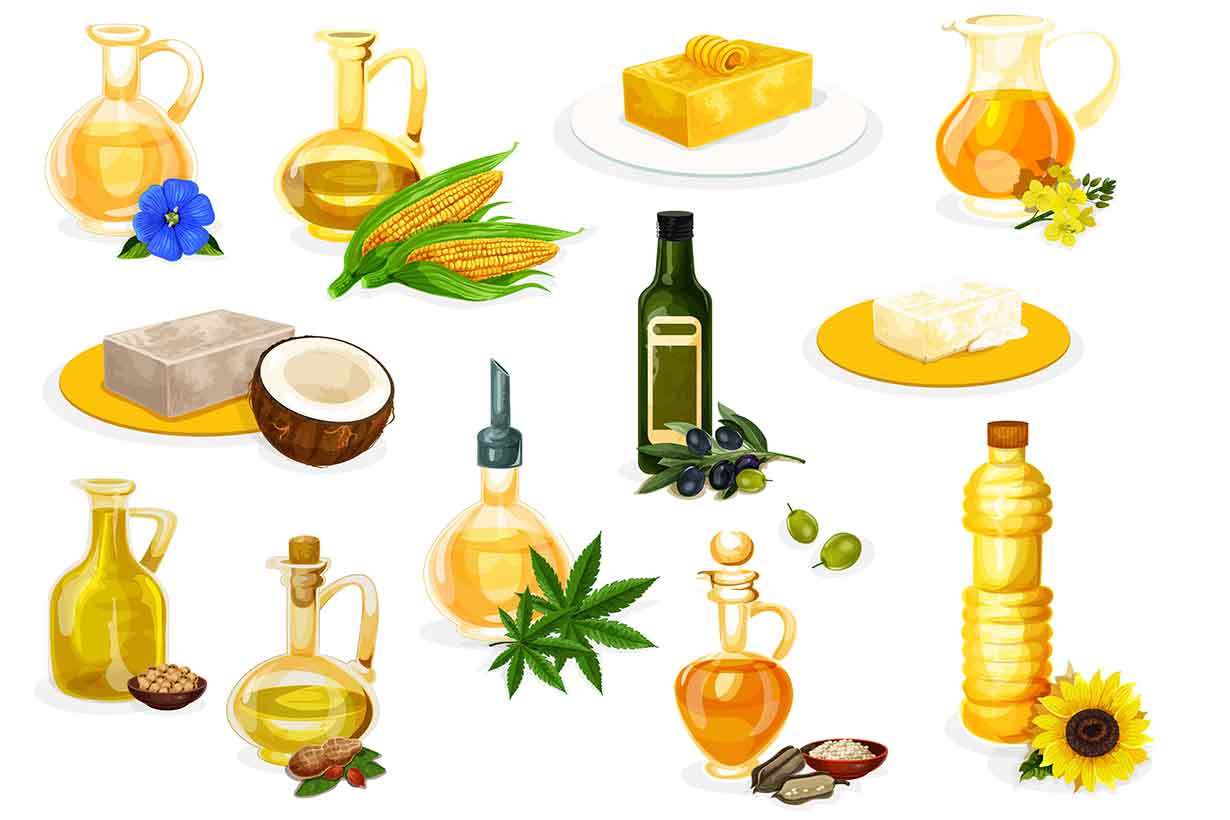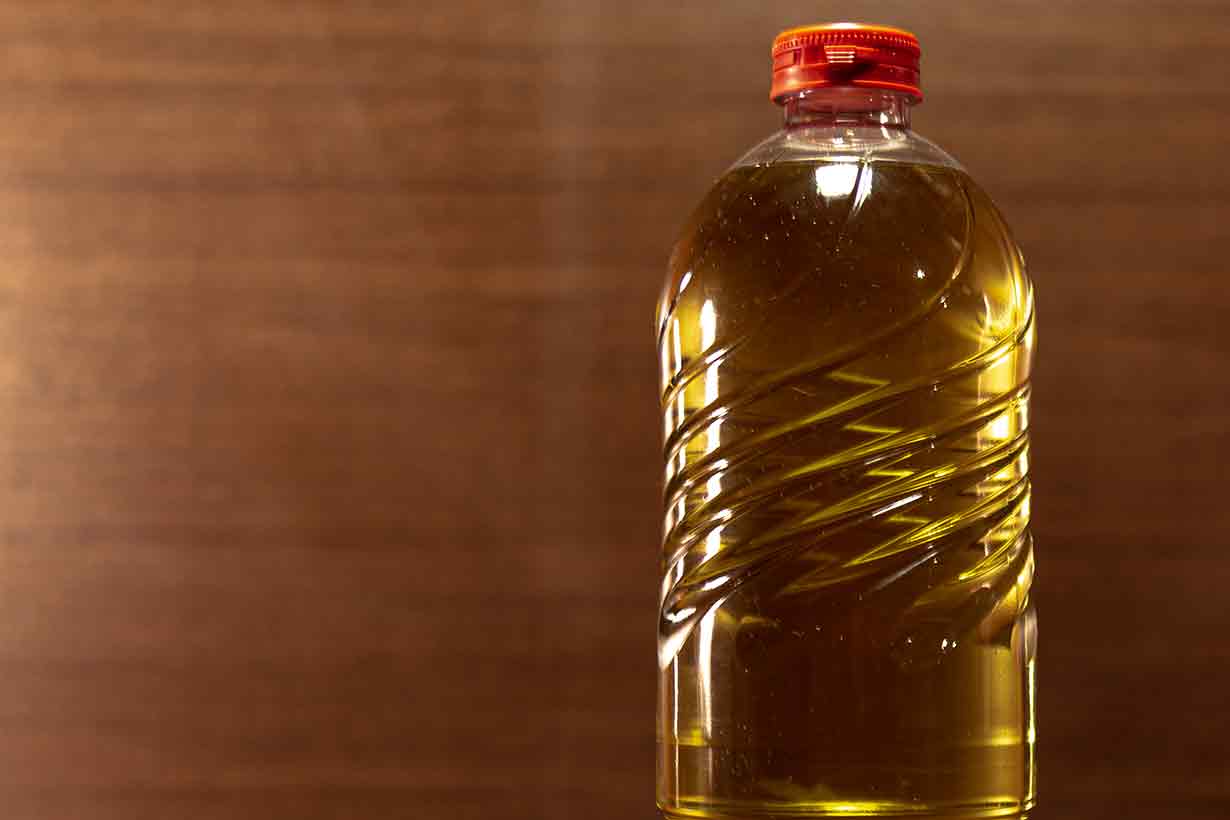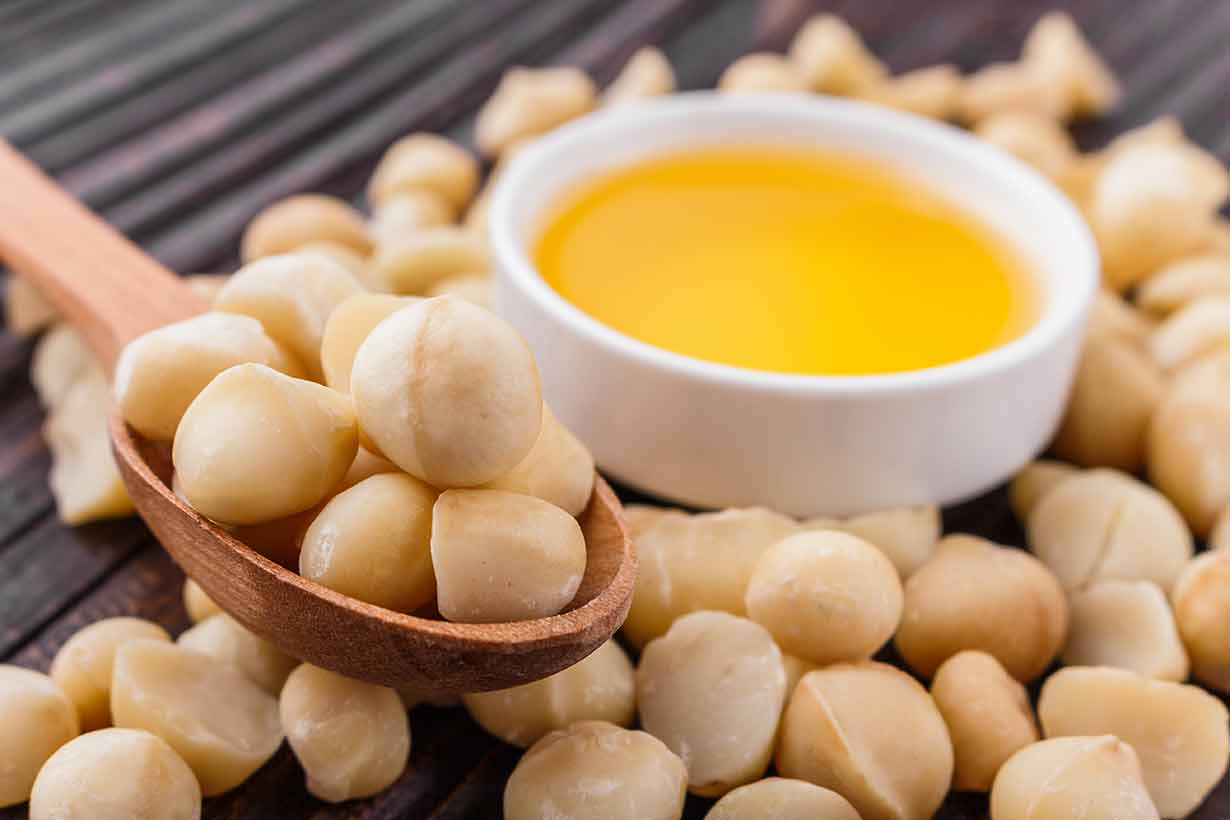High oleic sunflower is a type of cooking oil that provides some advantages over regular sunflower oil.
In this article, we will explore the benefits of high oleic sunflower oil, including its nutritional values and how it compares to regular sunflower oil.
We will also review findings from scientific research on the oil.
Table of contents
- What Is High Oleic Sunflower Oil?
- What Nutritional Values Does It Have?
- 4 Benefits of Using High Oleic Sunflower Oil
- How Does High Oleic Sunflower Oil Compare To Regular Sunflower Oil?
- What is the Fatty Acid Profile of High Oleic Sunflower Oil?
- How Does High Oleic Sunflower Oil Compare To Other Cooking Oils?
- Summary: Is High Oleic Sunflower Oil a Healthy Choice?
What Is High Oleic Sunflower Oil?

High oleic sunflower oil is a type of sunflower oil made from sunflower seeds that have been bred to have a high oleic acid content. Oleic acid is a monounsaturated fatty acid, the same type of fat found in olive oil and avocado oil.
High oleic sunflower oil typically contains more than 80% oleic acid by weight, while regular sunflower oil provides less than 20% (1, 2).
The main fatty acid in regular sunflower oil is linoleic acid, a polyunsaturated fat that is not as heat stable as oleic acid. This means that linoleic acid can more easily break down (oxidize) and form free radicals when heated to high temperatures (3).
Free radicals are unstable molecules that can damage cells, especially when they outnumber antioxidants in the body (4).
This lower oxidative resistance may not be a major concern for short-duration home cooking. However, for deep-frying at high temperatures and longer industrial-style cooking, high oleic sunflower oil is significantly more heat stable, making it a better choice for these applications.
What Nutritional Values Does It Have?
The following tables show the nutritional profile of a 14-gram tablespoon of high oleic sunflower oil.
The data was sourced from the USDA FoodData Central database, and percent daily values were calculated using the FDA’s published daily values (1, 5).
| Name | Amount | % Daily Value |
|---|---|---|
| Calories | 124 kcal | |
| Carbohydrates | 0 g | 0% |
| Fiber | 0 g | 0% |
| Sugars | 0 g | |
| Fat | 14.0 g | 17.9% |
| Saturated | 1.38 g | 6.9% |
| Monounsaturated | 11.7 g | |
| Polyunsaturated | 0.53 g | |
| Omega-3 | 0.03 g | |
| Omega-6 | 0.50 g | |
| Protein | 0 g | 0% |
| Cholesterol | 0 mg | 0% |
High oleic sunflower oil is primarily a source of monounsaturated fatty acids, with a small amount of saturated fat and even lower amounts of polyunsaturated fat.
Vitamins
| Vitamin | Amount | % Daily Value |
|---|---|---|
| Choline | 0.03 mg | <0.1% |
| Folate | 0 mcg | 0% |
| Vitamin A, RAE | 0 mcg | 0% |
| Vitamin B1 (thiamin) | 0 mg | 0% |
| Vitamin B2 (riboflavin) | 0 mg | 0% |
| Vitamin B3 (niacin) | 0 mg | 0% |
| Vitamin B5 (pantothenic acid) | 0 mg | 0% |
| Vitamin B6 (pyridoxine) | 0 mg | 0% |
| Vitamin B12 (cobalamin) | 0 mg | 0% |
| Vitamin C | 0 mg | 0% |
| Vitamin D | 0 mcg | 0% |
| Vitamin E | 5.75 mg | 38.3% |
| Vitamin K | 0.76 mcg | 0.6% |
High oleic sunflower oil, like other isolated fats, is not a good source of vitamins. However, it does contain a significant amount of vitamin E.
Minerals
| Mineral | Amount | % Daily Value |
|---|---|---|
| Calcium | 0 mg | 0% |
| Copper | 0 mg | 0% |
| Iron | 0 mg | 0% |
| Magnesium | 0 mg | 0% |
| Manganese | 0 mg | 0% |
| Phosphorus | 0 mg | 0% |
| Potassium | 0 mg | 0% |
| Selenium | 0 mg | 0% |
| Sodium | 0 mg | 0% |
| Zinc | 0 mg | 0% |
High oleic sunflower oil is not a dietary source of minerals.
4 Benefits of Using High Oleic Sunflower Oil
Here is a summary of the benefits that high oleic sunflower can provide.
1) High Smoke Point
High oleic sunflower oil has a high smoke point of 450°F (232°C) (6). This means that it can be heated to high temperatures without breaking down and smoking. When an oil breaks down, it can produce free radicals and toxic aldehydes, such as acrolein (7, 8, 9).
These compounds may have detrimental effects on human health (10). Therefore, in general, oils with a high smoke point are better suited for cooking at high-heat temperatures.
However, it is worth noting that smoke point is not the only factor that determines how prone to oxidation an oil is. The oil’s overall oxidative resistance is also important.
2) A Rich Source of Vitamin E
High oleic sunflower oil provides a good source of vitamin E. Each 14-gram tablespoon contains 5.75 mg of the vitamin, which is equivalent to 38% of the daily value for the vitamin (1, 5).
On a per-100-gram basis, the vitamin E content is 41.1 mg, which is equal to 274% of the daily value.
Vitamin E is an antioxidant that helps to protect cells against free radical-induced damage (11, 12). It is also important for the immune system and skin health (13, 14).
3) May Lower LDL Cholesterol (LDL-C) Levels
A randomized controlled crossover trial published in the Journal of the American Dietetic Association examined the effect of high oleic sunflower oil on the lipid (cholesterol) profile of nine middle-aged men with hypercholesterolemia (excessively high cholesterol levels) (15).
The men were assigned to consume either a palm, sunflower, or MCT oil supplement each day for three weeks in a metabolic ward. The diets were matched for all nutrients except the fat supplements, which were provided in significant amounts and contributed 43% of daily energy needs.
After three weeks, there was a break of one week or more, the length of which was up to the patients. The men were then assigned to one of the other oil supplements for three more weeks, followed by a further break of at least one week. The last three weeks of the study were spent consuming the remaining oil supplement.
The mean LDL-C concentrations for each dietary period were as shown below (15):
| Dietary Period | Mean LDL-C (mmol/dL) | Mean LDL-C (mg/dL) |
|---|---|---|
| Palm oil | 4.37 mmol/dL | 169 mg/dL |
| High oleic sunflower oil | 3.72 mmol/dL | 144 mg/dL |
| MCT oil | 4.27 mmol/dL | 165 mg/dL |
The results of this study suggest that using high oleic sunflower oil over oils that are predominantly saturated fat may significantly lower LDL-C levels. This is supported by the findings of similar randomized controlled trials, which have also found that replacing saturated fats with high oleic sunflower oil significantly reduces LDL-C (16, 17).
LDL-C is a recognized risk factor for cardiovascular disease, with higher levels increasing risk (18).
4) Less Prone To Oxidation Than Regular Sunflower Oil
As mentioned earlier, high oleic sunflower oil is more heat-stable than regular sunflower oil.
This is because it has a higher content of oleic acid, a monounsaturated fatty acid with one double bond in its structure.
Polyunsaturated fats, on the other hand, have multiple double bonds, which can react with oxygen and cause oxidation. When oils oxidize, they can generate harmful compounds like free radicals and aldehydes (8, 19, 20, 21).
How Does High Oleic Sunflower Oil Compare To Regular Sunflower Oil?
To provide a comparison of the differences between high oleic and regular sunflower oil, the following table shows their nutritional values per 14-gram tablespoon serving and basic characteristics (1, 2):
| Value | High oleic sunflower oil | Regular sunflower oil |
|---|---|---|
| Calories | 124 kcal | 124 kcal |
| Fat | 14.0 g | 14.0 g |
| Saturated | 1.38 g | 1.44 g |
| Monounsaturated | 11.7 g | 2.73 g |
| Polyunsaturated | 0.53 g | 9.2 g |
| Linoleic acid content | 0.50 g (3.6% of total fat) | 9.2 g (65.7% of total fat) |
| Oleic acid content | 11.6 g (82.9% of total fat) | 2.73 g (19.5% of total fat) |
| Oxidative resistance | Higher oxidative resistance | Lower oxidative resistance |
| Vitamin E content | 5.75 mg | 5.75 mg |
| Taste | Neutral, tasteless | neutral (refined), nutty (cold-pressed) |
What is the Fatty Acid Profile of High Oleic Sunflower Oil?
Some people may be interested in the complete fatty acid breakdown of high oleic sunflower oil.
Here is a list that shows the fatty acids that a 14-gram tablespoon of high oleic sunflower oil contains and in what amount (1):
- Myristic acid (saturated fatty acid): 0.01 g
- Pentadecyclic acid (saturated fatty acid): 0.11 g
- Palmitic acid (saturated fatty acid): 0.52 g
- Stearic acid (saturated fatty acid): 0.61 g
- Behenic acid (saturated fatty acid): 0.14 g
- Palmitoleic acid (monounsaturated fatty acid): 0.01 g
- Oleic acid (monounsaturated fatty acid): 11.6 g
- Paullinic acid (monounsaturated fatty acid): 0.14 g
- Linoleic acid (polyunsaturated fatty acid – omega-6): 0.50 g
- Alpha-linoleic acid (polyunsaturated fatty acid – omega-3): 0.03 g
How Does High Oleic Sunflower Oil Compare To Other Cooking Oils?
Here are some ways in which high oleic sunflower oil compares and differs from various cooking oil options:
- Other high oleic oils: High oleic sunflower oil has a similar fatty acid composition and overall nutritional profile to other high oleic oils, such as high oleic canola, safflower, and soybean oil. Since they have a similar fatty acid composition, each oil should have a similar degree of oxidative stability when exposed to high temperatures.
- Olive oil and avocado oil: Olive and avocado oils are also primarily monounsaturated fatty acids with a good degree of oxidative stability (22, 23). However, they tend to be a lot more expensive than high oleic sunflower oil.
- Butter, coconut oil, ghee: Saturated fats like butter, coconut oil, and ghee are also relatively heat stable cooking fats that are not prone to oxidation. However, they are more expensive than high oleic sunflower oil. Additionally, saturated fats tend to increase LDL-C levels compared to predominantly unsaturated fats (24).
- Primarily polyunsaturated cooking oils: Cooking oil options like regular sunflower oil, rice bran, safflower, and soybean oil, are mainly a source of polyunsaturated fat. These oils are cheaper than high oleic oils, but they are more prone to oxidation. As a result, they are not as well-suited for high-temperature cooking over long periods.
Summary: Is High Oleic Sunflower Oil a Healthy Choice?
As shown throughout this article, high oleic sunflower oil has some advantages over regular sunflower oil for cooking at high-heat temperatures. This is because it has a high monounsaturated fat content, which makes it less likely to oxidize when exposed to high-heat temperatures. In this regard, high oleic sunflower oil has significantly lower oxidation rates than polyunsaturated oils when used for cooking methods such as industrial deep-frying and other long-duration cooking times.
High oleic sunflower oil is a good source of vitamin E and has been shown to lower LDL-C in clinical trials, compared to more saturated fats.
It has a nutritional composition similar to other oils high in monounsaturated fat, such as olive oil and avocado oil. However, extra virgin olive oil has a wider evidence base for positive human health outcomes than other cooking oils.
That said, high oleic sunflower oil is a more affordable option than extra virgin olive oil, making it a relatively healthy and affordable choice for cooking oil.
For more information on the best frying oils, see this guide:








